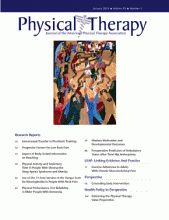Abstract
Background Intermanual transfer may improve prosthetic handling and acceptance if used in training soon after an amputation.
Objective The purpose of this study was to determine whether intermanual transfer effects can be detected after training with a myoelectric upper-limb prosthesis simulator.
Design A mechanistic, randomized, pretest-posttest design was used.
Participants A total of 48 right-handed participants (25 women, 23 men) who were able-bodied were randomly assigned to an experimental group or a control group.
Intervention The experimental group performed a training program of 5 days' duration using the prosthesis simulator. To determine the improvement in skill, a test was administered before, immediately after, and 6 days after training. The control group only performed the tests. Training was performed with the unaffected arm, and tests were performed with the affected arm (the affected arm simulating an amputated limb). Half of the participants were tested with the dominant arm and half with the nondominant arm.
Measurements Initiation time was defined as the time from starting signal until start of the movement, movement time was defined as the time from the beginning of the movement until completion of the task, and force control was defined as the maximal applied force on a deformable object.
Results The movement time decreased significantly more in the experimental group (F2,92=7.42, P=.001, ηG2=.028) when compared with the control group. This finding is indicative of faster handling of the prosthesis. No statistically significant differences were found between groups with regard to initiation time and force control. We did not find a difference in intermanual transfer between the dominant and nondominant arms.
Limitations The training utilized participants who were able-bodied in a laboratory setting and focused only on transradial amputations.
Conclusions Intermanual transfer was present in the affected arm after training the unaffected arm with a myoelectric prosthesis simulator, and this effect did not depend on laterality. This effect may improve rehabilitation of patients with an upper-limb amputation.
Footnotes
All authors provided concept/idea/research design, writing, and project management. Ms Romkema provided data collection and study participants. Ms Romkema and Dr Bongers provided data analysis. Dr van der Sluis provided institutional liaisons. Dr Bongers and Dr van der Sluis provided fund procurement, facilities/equipment, and consultation (including review of manuscript before submission).
The authors thank Suzanne Broeks and Katja Golea for assistance with collecting data. Johan Horst and Theo Schaaphok, OIM Orthopedie, are acknowledged for their technical assistance with the simulator. Peter Kyberd, Ann Kyberd, and Jim Burkitt are acknowledged for their help with revising the manuscript.
The treatment of the participants in this study was in accordance with the Medical Ethics Committee of University Medical Center Groningen (NL35268.042.11).
This study was supported by grant 60-62300-98-119 from ZonMW.
Nederlands Trial Register (NTR) registry number: NTR3053.
- Received February 13, 2012.
- Accepted September 4, 2012.












